- Camping Tips
- Hiking Tips
- RV Camping
- Destinations
- Blog
- Gear Reviews
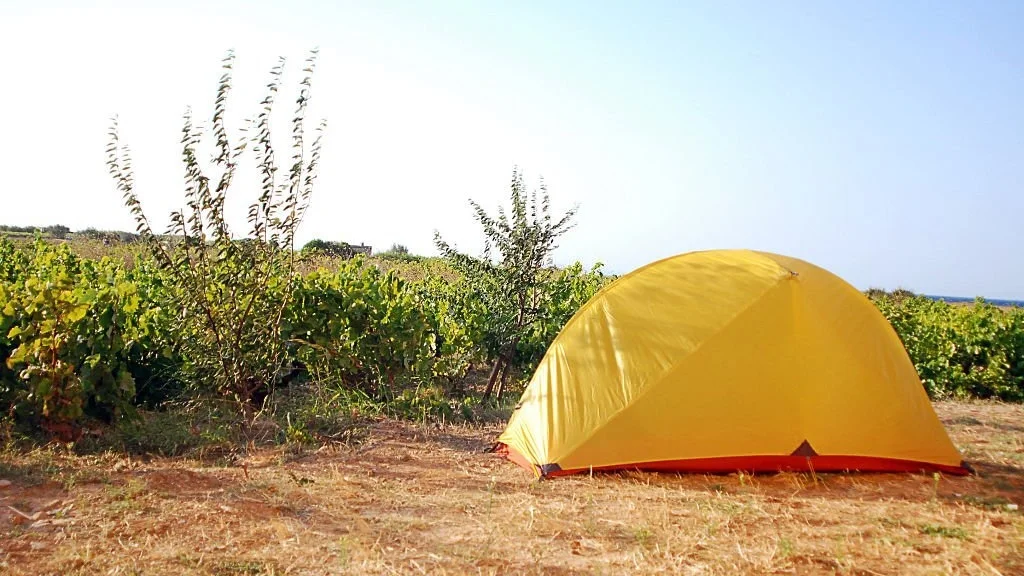
According to Kampgrounds of America (KOA) – June 2021 Edition, almost half of all campers planned on camping during the summer season. As compared to winter camping, camping during summer or other hot-weather seasons has its obvious benefits such as favorable temperatures, the need for less gear, and higher affordability.
However, the hot summer is not an all-glam-and-no-sham affair. Your tent can quickly feel like a sauna with the sun beating down on it all day long.
Perspiration and respiration further compound the problem by releasing water vapor and carbon dioxide inside the tent. The result is that the tent will then trap heat leaving the interior feeling like an oven.
Fortunately, there are a few practical and low-cost coping mechanisms you can count on to survive the intense heat. In this guide, we take you through some of the most practical tricks to keep your tent cooler in the hot summer weather.
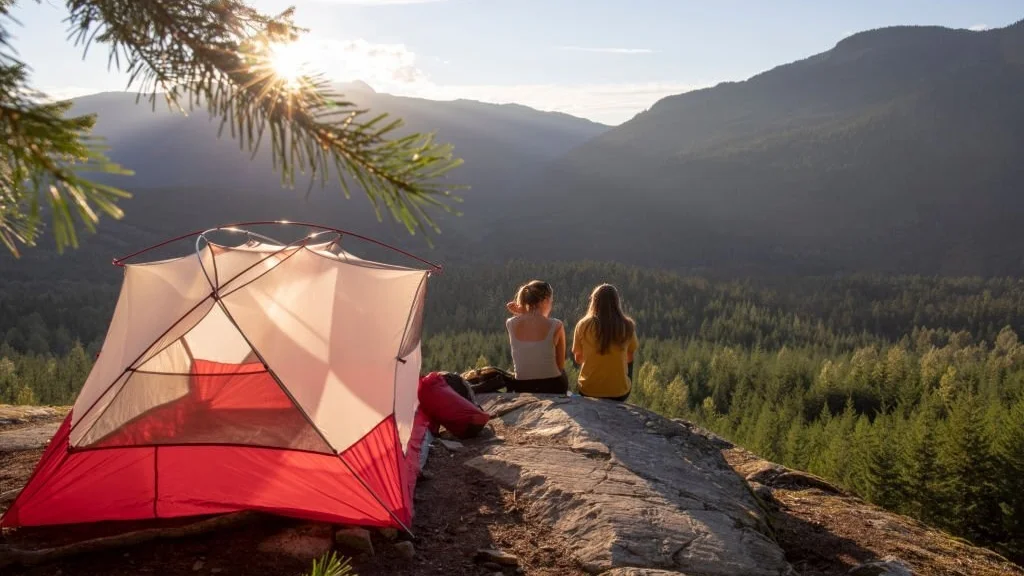
If you don’t already have a camping tent, it is prudent that you pick one that is suitable for hot-weather camping. A few factors to look out for when buying your summer camping tent include its seasonality, fabric material, design, size, and color.
Tents rated one-season or two-season are the most suitable for hot weather camping.
While one-season tents feature the most basic material and come without the rainfly, tents rated two-season come with the rainfly but are still basic. Both tents, and especially one-season tents, offer minimal waterproofing, but lots of ventilation. Two-season tents can be stretched into fall but one-season tents are only meant for summer camping.
You will likely notice how unpopular 1-season tents are. So rare are they that you might actually not find one when looking to buy. In that case, 2-season tents will be your best bet to counter the summer heat.
Beyond the tent season rating, you want to go for polycotton, cotton, or canvas fabrics as opposed to the more popular polyester or nylon variants. Though heavier than the latter, cotton-based tents are more breathable and more effective at keeping the tent interior cool.
Ideally, you want the tent fabric to be further treated with UV-resistance properties to prevent the sun’s harmful rays from permeating into the tent’s interior.
Peak airflow is the key to keeping your tent cool in hot weather. Therefore, any feature that promotes optimal air circulation in and out of the tent is highly welcome. A larger tent with plenty of headspace and elbow room will be much cooler than a smaller one.
Bell and Cabin tents are designed to have higher headroom resulting in comfier and cooler interiors, unlike conventional dome tents.
When camping in summer, you want to haul along the larger of your tents. So, instead of the usual two-person tent, you may want to consider packing the four-person tent if you have one. Keep in mind that if you are sharing the space with many roommates, the airflow aspect might be minimal.
Dark-colored canopies absorb more sunlight and in turn convert it into heat. Light-colored canopies, on the other hand, reflect away some light leaving only a fraction to be converted into heat. So, if you desire cooler interiors, always go for light-colored tents.
But since light-colored canopies tend to be too lit inside, you may want to try out the newer blackout or darkroom tents that have white exteriors and dark interiors. Here, sunlight will supposedly bounce off the tent’s exterior leaving the interior cool but with minimal light. But keep in mind that such tents will most likely suffer when it comes to ventilation, another critical factor in keeping the tent cooler.
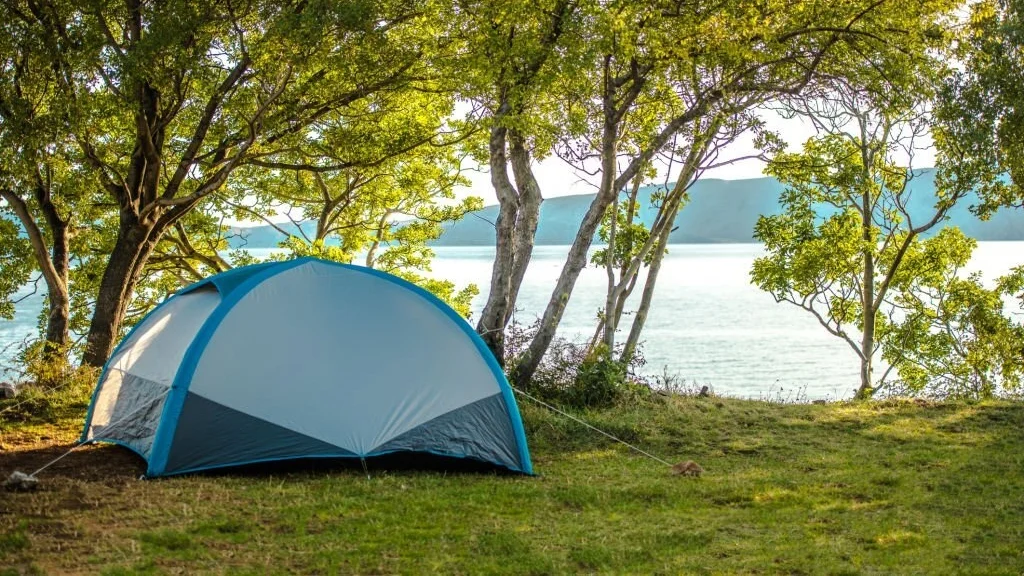
When pitching a tent, two factors are critical in determining whether its interior will remain cool or gradually turn into a heated torture chamber. These factors are the location and time.
When choosing your campsite location, you want to steer clear of campgrounds with rocky or asphalt terrains. Like urban areas, bare grounds or asphalt tend to be much warmer than surfaces with grass or other vegetation.
Ideally, you want to pitch your tent on grass-covered surfaces for a cooler interior. If that is not an option, then you probably want to use some ground cover to protect you from the hot ground. Using a tent footprint or spreading a layer of dried leaves or some cardboard boxes will do the trick.
In rainy seasons, it’s unwise to pitch your tent under a tree. In summer, however, pitching your tent under a tree protects its ceiling from direct sunlight which in turn helps keep its interior cooler. The caveat when camping under tree cover is to always be on the lookout for the dreaded widow makers. These are any dead or loose tree limbs that could suddenly fall with catastrophic outcomes.
In areas with limited or nonexistent tree cover, you can create your own sunshade by using a tarp or awning over your tent. Reflective tarps or emergency space blankets work best since they not only provide shade but also reflect the sun’s rays.
In summation, your ideal camping location should always take advantage of natural cooling. Try moving to higher grounds or camping near water bodies where there is a greater chance of catching a cooling breeze. Primarily, you want to set up your tent in such a way that its doorway faces toward the breeze.
Some proven ways to tell where the wind is blowing include asking the local rangers, using the wet finger trick, holding a grass blade in the wind, or just consulting with most weather mobile applications.
For crowded festivals or high-traffic campgrounds, try setting up camp on the very outskirts of the area for a cooler experience.
In summer, you want to avoid setting up your tent when the sun is still too hot. Setting up your tent at night, at sunset or late afternoon is almost an assurance that your tent’s interior will be cool. Similarly, you want to take it down during the day to avoid hot air from getting trapped in the tent’s interior.
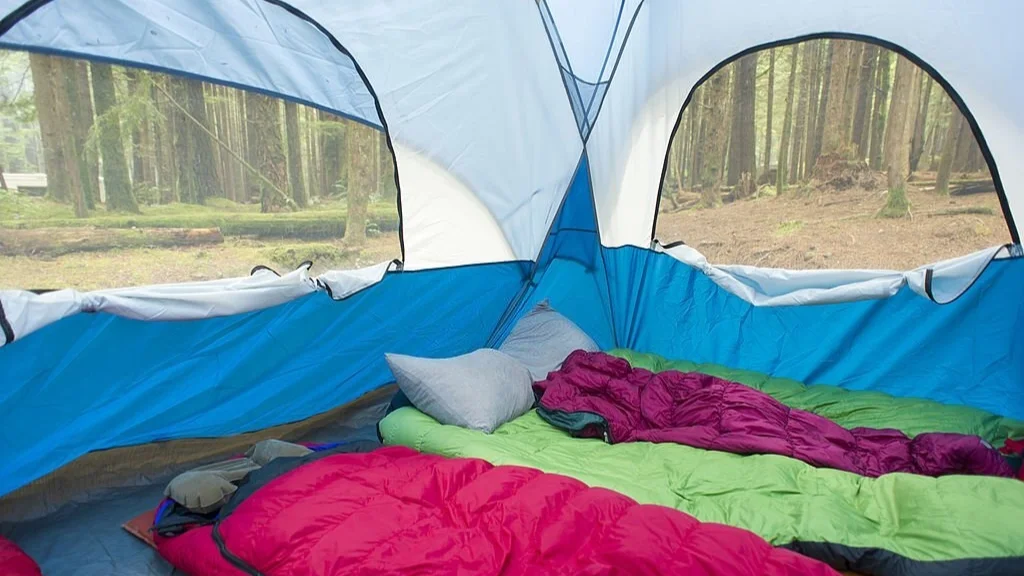
Primarily, your outdoor shelter should be designed to allow optimal airflow. This means your tent should come with multiple doors, large windows, and vents all around. Additionally, bug screens should be installed at all openings to keep annoying pests and mosquitoes from disrupting your stay inside the tent.
Keeping these air outlets open is the simplest way to ensure the interior of your tent remains cool. That way, the heat transfer dynamics will be on your side. Cold air will get in through the doors and windows while hot air rises out through the ceiling vents or mesh canopy.
Furthermore, the cooling effect created by the consequent wind tunnel effect will help you.
Most double-walled tents come with all-mesh canopies which allow you to eliminate the flysheet for even more ventilation. Similarly, leaving out the flysheet or rainfly means that you can drift off to sleep while stargazing.
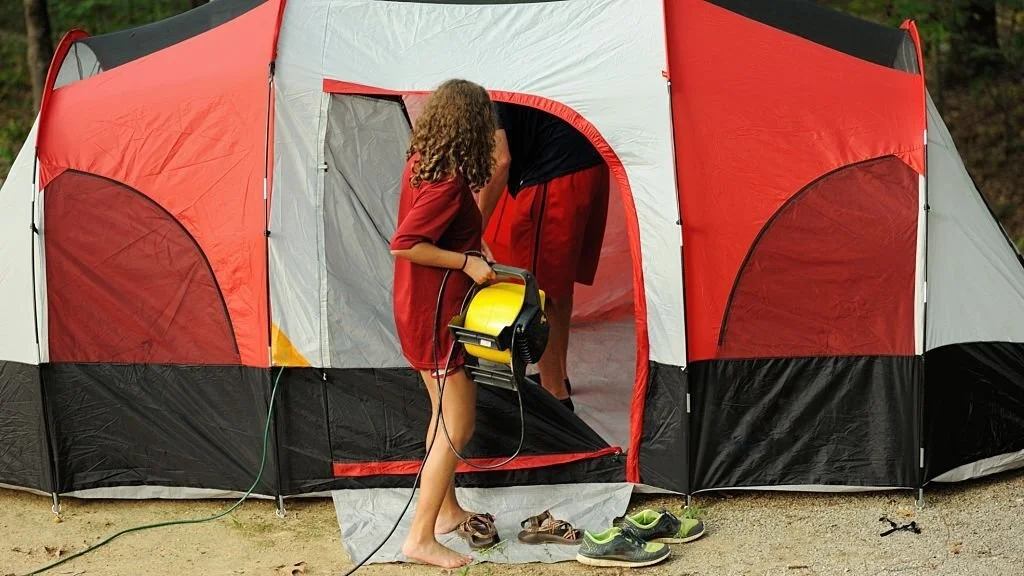
Yes, using actual fans and portable AC units is your next step to staying cool when summer camping. Some of the units might be best suited to car campers but there’s a good variety of choices for backpackers and ultralight campers to take advantage of.
Portable electric fans are either powered using traditional D-cell or C-cell batteries or rechargeable batteries. The latter is often the more convenient, affordable, and camping-friendly option. In either case, if you desire additional airflow, a larger-diameter fan with a larger battery capacity should suffice.
Depending on the size of your tent, your camping style, or personal preferences, being able to hang the fan might be of significance.
Floor camping fans will be more effective at keeping the interior cool while hanged camping fans excel at being super lightweight and highly adjustable. However, hanging camping fans provide less airflow.
Moreover, when picking your ideal camping fan, you may want to consider their operating noise levels. Always go for camping fans that operate at less than conversational noise levels, that is, 60 decibels.
Safety measures, no matter how trivial they might seem, should be similarly present in your dream camping fan.
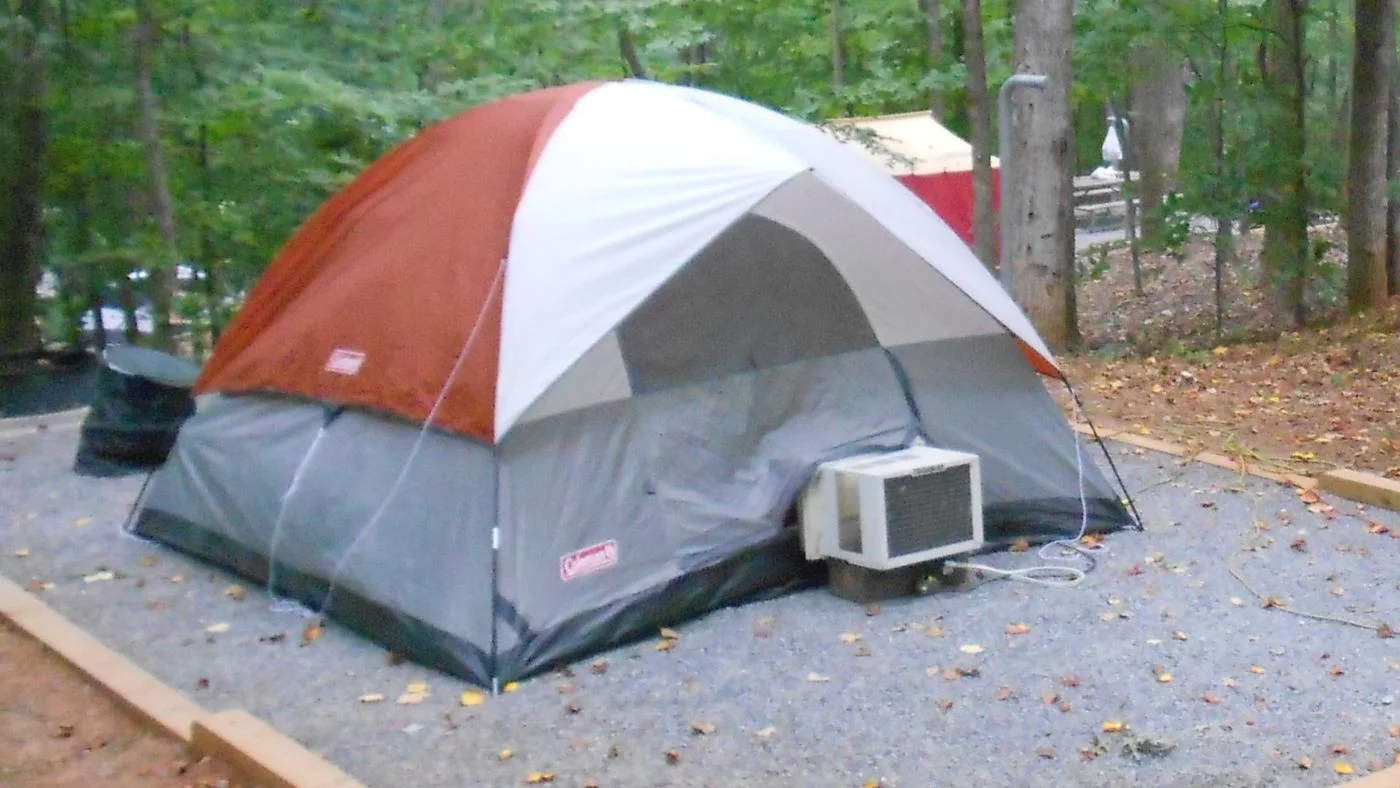
Air conditioning systems are the obvious next level if other cooling systems don’t work. Sure, they can be slightly expensive, bulky, and power-hungry but overall, air conditioners are the quickest and easiest method to cool things down.
There are three different sorts of air conditioners that will work well in your camping environment. Evaporative coolers, portable air conditioners, and window-mounted air conditioners are among them.
Evaporative coolers, also known as swamp coolers, work best as personal coolers than full-tent air coolers. They work by pulling in hot air with a fan and blowing it over wet cooling pads, which then dispels a cool mist into the given direction. The cold mist can cool the air by 15 to 40 degrees Fahrenheit. The big idea behind their functionality is that air temperature lowers when water is evaporated on it.
However, evaporative coolers are most effective when the humidity in the tent is relatively low and they rely on the continuous use of water.
Though touted as “portable”, portable air conditioners are often a bit bulky but still manageable for most car campers. Portable ACs are either electrically powered or battery-powered with the latter being the least reliable and most expensive.
Portable air conditioners are notorious for taking up too much space and providing a less powerful airflow. But they easily make for this by running quieter than other options, installing fully indoors, and being more power-efficient than window ACs.
Like home versions, window-mounted air conditioners are fitted through the wall of the tent. So, installing them might mean adapting the tent or buying a tent with an AC port or vent. Additionally, window ACs require an EHU connection or any other suitable portable power supply.
That said, tent window ACs are arguably the most powerful option yet and will even work for large-capacity camping tents.
Irrespective of which type of air conditioner you go for, always consider the following key factors: the cooling power, power requirements, operating noise levels, weight, and additional convenience features.
The cooling power will often be given in BTUs (British thermal units), where a higher number means a higher cooling capacity. Any unit rated 5,000 BTUs or above should suffice for most small to medium-sized tents. For larger tents, you may want to go for a more capable AC unit rated at least 10,000 BTUs.
Evaporative coolers require very little energy while portable and window-mounted air conditioners require a bit more power to run smoothly. Most notably, we found window-mounted ACs to be more energy efficient in terms of transferring the power input to the actual cooling effect.
Keep in mind that power consumption can be greatly reduced by properly insulating your camping tent. While some units come battery-powered, a power generator or a connection to the mains might be required to run most of the tent air conditioners.
Like fans, you want the air conditioner to operate at around normal conversation noise levels. That said, evaporative coolers can run very quietly while portable and window-mounted air conditioners can be very noisy to operate. Furthermore, the more powerful an AC is, the noisier it will be.
When it comes to weight and portability, tent air conditioners are undoubtedly reserved for car campers. Most of the units are heavy and bulky and will even come with wheels for easier transportation and handling.
As we’ve seen above, evaporative coolers are super lightweight and portable as compared to the heftier portable and window-mounted tent ACs.
Understandably, tent air conditioners can fetch a pretty penny, so you might want to be a little creative with your tent cooling solutions.
You can try converting your portable fan into an evaporative-cooler-like cooling system. Place a block of ice or pour cold water on a shallow pan or trough then position it in front of the fan. The resulting misty “breeze” should cool you down for the night.
Remember to use a pan or trough that is big enough to hold the water when the ice starts to melt.
An even more radical idea is to drape your camping tent with wet towels. Preferred for its air permeability and condensation resistance, Hessian burlap fabric can be an ideal candidate for this purpose.
Simply soak the towels in water, wring them a bit to remove excess water, and then attach them to your tent. On very hot days, be sure to spray the towels with water to prevent them from drying and consequently losing the cooling effect.
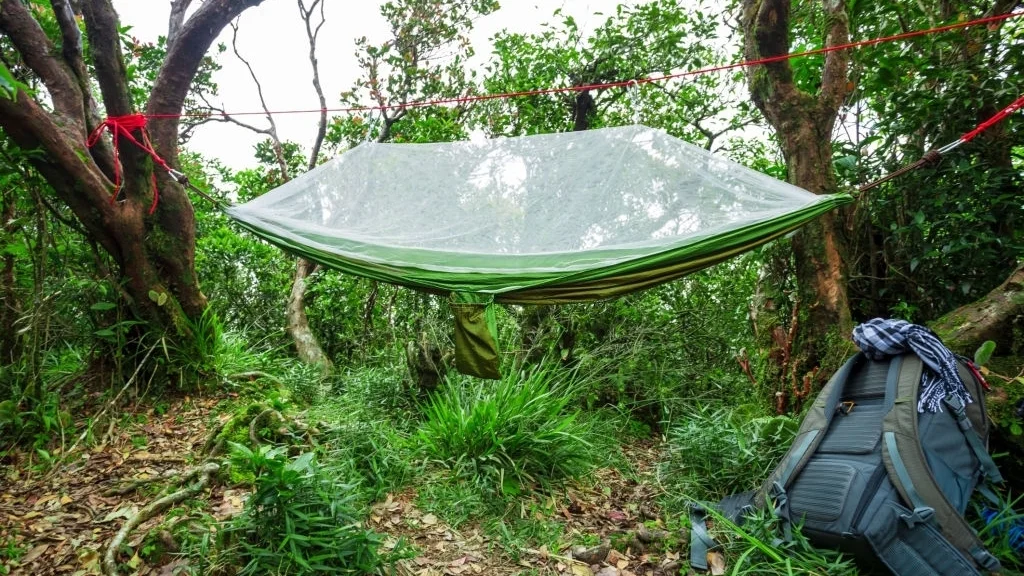
You can ditch the tent altogether and opt for a tarp, a large beach canopy, or a hammock.
Though it might not work for nighttime use, a canopy or tarp is perfect for daytime applications such as lounging, food prep, and eating stations.
Hammocks, on the other hand, provide the most air circulation and are arguably the best lounging option for summer camping. Their design allows for unobstructed airflow all around you, which might lead to the famed cold butt syndrome.
If the cold drafts from underneath get too much, then you could use some underquilts to improve the insulation. In addition, go for sleeping hammocks with minimal slouching profiles for a more comfortable experience. And since bugs and mosquitos can be a pain when sleeping in a hammock, be sure to carry with you a capable bug netting, and don’t forget to get some bug repellent.
Your camping tent can easily feel like a hotbox on most summer days. This is not only uncomfortable but could lead to numerous heat-related illnesses such as heat cramps, heat rash, heat exhaustion, or even heat stroke.
Thankfully, whether you have access to electricity or not, there are plenty of methods you can implement to beat the heat. Feel free to test them all out to figure out which one works best for you.
Charlie Leone
Website Owner/Editor
Welcome to CampingManiacs